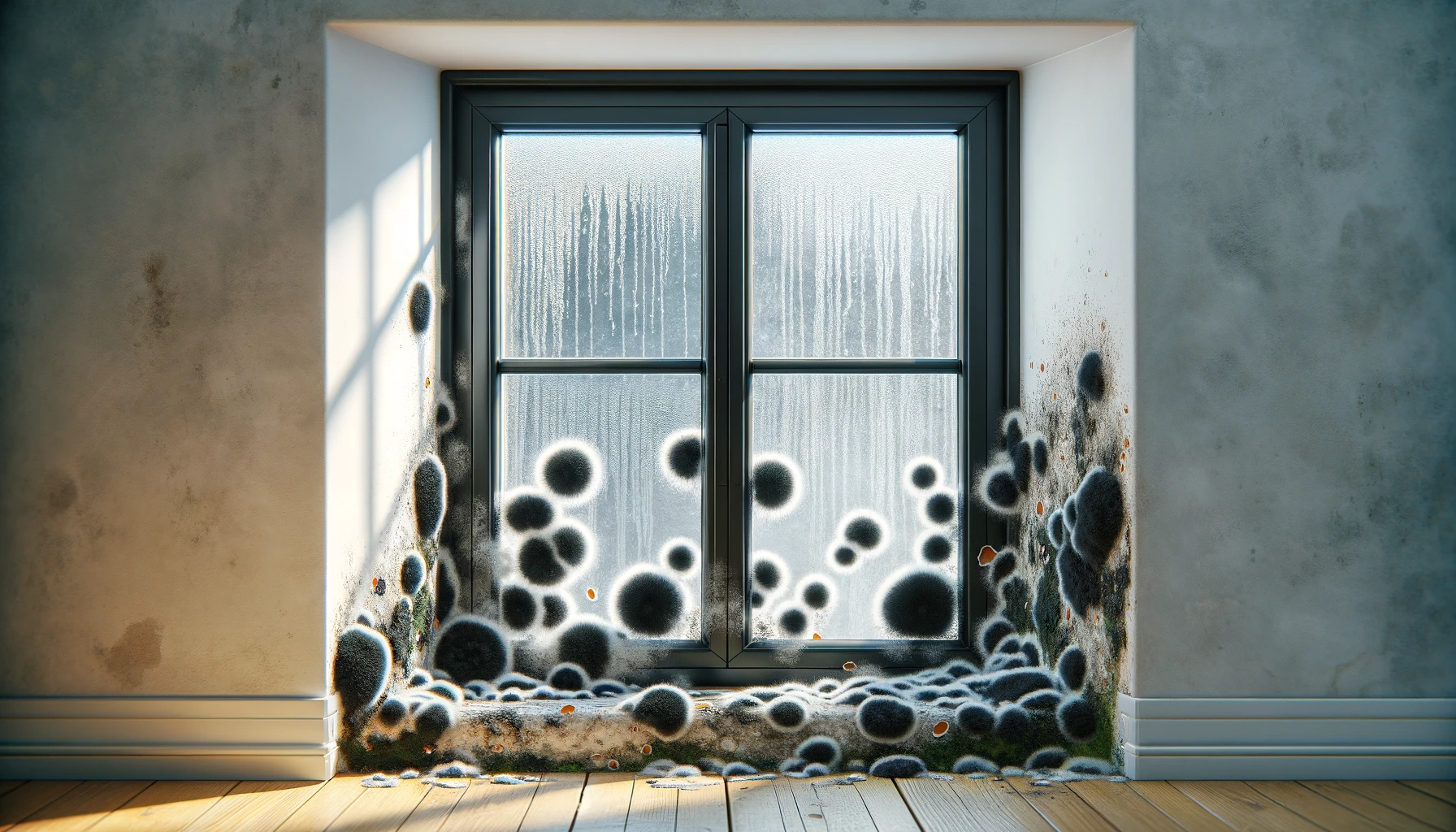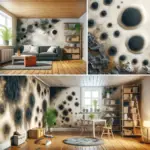Knowing the familiar mold sources in your property can help you avoid severe damage. Warm and humid areas are breeding grounds for mold. Windows, window sills, leaking roofs, and pipes in these environments can be common sites where it festers; however, any water-damaged or flooded area is susceptible to its presence.
During the wintertime, water (or moisture) often appears around your windows due to condensation. This dripped water causes damage to the drywall beneath the windows, leading to awful mold growth that can be difficult to manage.
Specifically, mold can go unnoticed on windows since it doesn’t always appear as a dark color. It’s often mistaken for innocuous dust and therefore ignored until later.
Consequently, the mold is given more opportunities to cause harm- indoors and out. The windows are just one of many areas affected by excessive time without proper home maintenance, causing significant stress for any homeowner.
Without a doubt, mold should never be overlooked or underestimated in any form or quantity. If you detect any signs of mold near windows or anywhere else in your home, it is essential to take action immediately. It is essential to be informed of the facts surrounding mold, understand how to spot it, and take steps to prevent its reappearance. Here are a few critical pieces of information that will help you do that.
What is Mold?
Mold is a type of fungus that can be found in any damp, warm environment. It can take on different colors and textures but is most commonly associated with black, pink or green discoloration. It typically grows in the places exposed to moisture, such as windows, walls, basements, bathrooms, roofs, etcetera. Everywhere that elevated moisture and a food source are present, mold grows. As a part of the Fungi kingdom, these living organisms reside in moist environments like soil, plants, and decomposing matter. In the environment, molds play a part in decomposing organic materials such as leaves and trees. However, indoor mold should be avoided at all costs.
Mold Growth
Mold growth is a natural occurrence in our environment, but it can be dangerous and destructive when it infiltrates homes and businesses. In many cases, mold spores are present in the atmosphere and only become active when they land on wet surfaces such as windows, walls, carpets, and furniture.
Molds propagate by releasing minuscule reproductive cells known as spores that drift in the air. Microscopic mold spores (sizing between 2-10 um) are nearly invisible to the naked eye. They circulate throughout indoor and outdoor air, with some types of molds releasing their spores at each disruption or disturbance. Certain molds produce sticky spores that cling to surfaces and can be released by mechanical impacts, like brushing against or touching them directly.
Spores have the remarkable ability to remain viable for years, even after they are produced.
Black mold in Window Sills and the Window Frame
Black mold in window sills and window frames is a common problem. Not only can black mold weaken the structural integrity of your windows, but it can also spread to other areas of your home and create an unhealthy environment. In the home, dust composed of various elements such as dead skin cells, hair strands, bacteria, and plastic fragments can lead to mold growth. If this combination is exposed to moisture and warmth, it will likely result in mold growth.
Unknown to many, mold on window sills and frames can quickly proliferate; it begins growing at the juncture of a window’s glass and sash frame – usually from the bottom up. Generally, the mold is distinguishable by its color; however, in some instances, it can take on a similar shade to the window frame, making visibility nearly impossible.
If the black mold found in your windows has now extended to the Sheetrock under or around it, then you must take serious action. Hire a professional expert as soon as possible who can safely and entirely remove all evidence of fungus from the entire structure – including walls and window frames. This is essential to ensure that your home is safe from any potential health risks associated with black mold exposure. When mold penetrates your walls and causes substantial harm, it may be necessary to remove portions of the wall for repair altogether.
Moisture is the leading cause of mold growth from leaks or condensation. Bathroom and kitchen windows are especially prone to it, but any window sill can be affected.
Unless you address the source of moisture, scrubbing your window frames is merely a temporary solution; mold will almost certainly reconvene in short order. Untreated mold accumulation will inevitably cause harm to your windows over time. Additionally, the mold spores released during cleaning can cause harm to your eyes and skin; it may even hurt your lungs, throat, and nervous system.
Mold on Glass
Another common issue with mold growth is on glass windows. While it may be easier to see, it can also be hard to treat. Not only does the mold discolor the windows, but it can also make them less transparent and cause further damage. Mold growth should not be an issue on glass window panes as they are not organic. Nevertheless, mold may set in if you haven’t kept your glass windowpanes consistently clean and dust-free.
Additionally, if moisture is trapped between the double panes of a window, this can cause mold between glass panes. Sometimes tiny cracks form, allowing damp conditions and a food source to enter the space between panes. Moisture builds up if your window seal is damaged. Generally, window mold inside the layers of glass is not fixable. Investing in new windows may be your best option at this stage, as you cannot reach between the panes for a thorough cleaning.
How do I stop condensation on my windows?
Condensation can be a sign of a bigger problem in your house, not only for the potential mold growth but also because your household has weak spots or thermal bridges in its insulated envelope. This could be sourced from issues within the basement, crawlspaces, walls, and ventilation systems – not to mention condensation running down windows which are all warning signs that shouldn’t be ignored.
To reduce condensation buildup on your windows, it’s important to maintain a low humidity level in your home. Utilize dehumidifiers and close bathroom and kitchen doors while running the fan during showers. Also, check for any water leaks so you can keep an optimal indoor environment of 60% humidity or lower. These simple steps will help ensure your house remains free from excessive moisture levels. These simple steps will help ensure your house remains free from excessive moisture levels.
How to Prevent Black Mold on Windows and the window frames
There are several key steps that you can take to prevent mold growth on your window frame and sill and minimize any damage caused by it. These include regularly inspecting your windows for signs of moisture and condensation, cleaning them often, using a dehumidifier if necessary, installing exhaust fans, and implementing strategies to limit humidity within your home.
Depending on the conditions, it can be beneficial to allow fresh air inside. Or running the air conditioning system to ensure proper ventilation.
Most importantly, it is essential to recognize the mold that grows on window sills early on. While humidity and organic matter are necessary for mold growth, they can sprout up on wood or aluminum window sills that are typically found in homes.
The presence of organic matter in domestic dust serves as a food source for mold. Combined with the moisture that accumulates on aluminum window sills, it makes an ideal breeding ground for its growth around your windows. A good time to inspect is while cleaning with a clean rag.
It’s also essential to open the windows from time to time and use a cleaning solution and clean rag to clean the frame. This finer examination will also help you to find mold or identify a potentially leaky window.
Wooden sills are vulnerable to mold and mildew growth, which can be prevented by painting the wood with glossy paint. Additionally, it is important to regularly dust your window sills when humidity levels are higher. Applying this protective measure will ensure that both the outside beauty of your home and its interior health remain safe from potentially hazardous elements.
As previously mentioned, removing mold can be a daunting and hazardous task, so hiring a professional for assistance is recommended.
Is black mold on windows harmful?
Black mold on windows can be harmful if left untreated, as it can cause damage to the surface of the windows and release toxic spores into the air. If you suffer from allergies or asthma, breathing in mold can aggravate your sickness. Even those with no mold allergies may suffer a variety of ill feelings, including itchy eyes, skin rashes, sore throat, runny nose, and lungs due to prolonged exposure to mold.
To protect against potential issues, the surest way proactively prevents mold growth on your windows in advance. This may include installing a dehumidifier, using ventilation fans, and regularly cleaning with mold-resistant products. Additionally, consulting with a professional mold removal service can help ensure that the problem is completely eradicated from your home.
How Can I Get Rid of Black Mold Around Windows?
With the correct safety precautions, you can use home remedies to safely and effectively remove mold from your windowsills you have to ensure to be aware of all existing mold. Taking steps like wearing protective clothing or using a disposable face mask and rubber gloves while dealing with mold is essential for protecting yourself against any potential side effects of handling it.
When it comes to eliminating mold from your window frames, take into account what type of frame they are. Removing mold from aluminum window frames is easy – soak them in a bleach solution for several minutes and then gently wipe away any remaining residue. This process ensures that your windows will shine clean and completely free of mold.
Treating wood window frames with a bleach mixture is not recommended, as it can corrode them. Furthermore, mold on such surfaces tends to seep deeper and be harder to eradicate without replacing your windows. It may still be worth a try to use a cleaning solution followed by an EPA rated disinfectant. However, you might have no choice but to replace these fixtures if all else fails.
When do I need Professional Help?
While it may be feasible to eliminate mold from your windowsills by yourself, the cleaning process can involve some risks. If you fail to take the necessary steps and use protective equipment when attempting to remove mold, it can spread and proliferate in other areas of your home. This not only affects air quality but may lead to respiratory issues or illnesses for those living within the house. Neglecting proper removal methods will cause any traces of mold that were once invisible in certain parts of your dwelling to begin growing, thus increasing their effects on both indoor air quality and personal well-being.
Removing Mold and preventing mold growth are areas that a professional will have extensive training.
If you cannot effectively remove black mold from windows on your own, it is recommended that you seek professional help. A qualified mold removal service will be able to assess your home and determine the severity of the problem, as well as provide safe and effective methods of removing the mold without causing any damage to your windows or home environment. Additionally, their expertise in addressing mold issues will ensure that all traces of the fungus are eliminated from your home so that you can enjoy clean windows and peace of mind.
[/et_pb_text][/et_pb_column][/et_pb_row][/et_pb_section]


